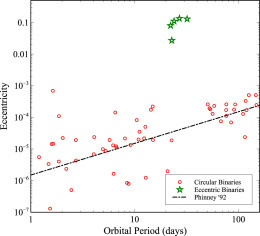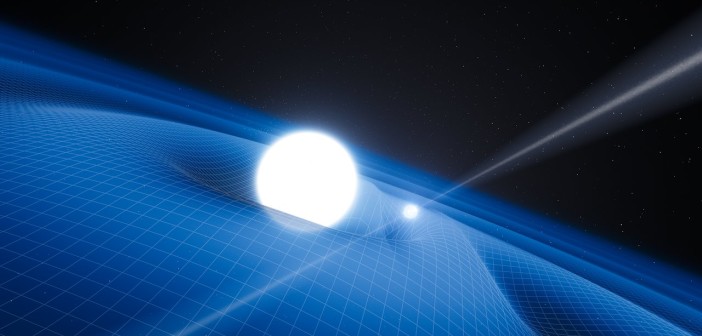Astronomers have discovered a binary system consisting of a low-mass white dwarf and a millisecond pulsar — but its eccentric orbit defies all expectations of how such binaries form.

Observed orbital periods and binary eccentricities for binary millisecond pulsars. PSR J2234+0511 is the furthest right of the green stars that mark the five known eccentric systems. [Antoniadis et al. 2016]
Unusual Eccentricity
It would take a low-mass (<0.4 solar masses) white dwarf over 100 billion years to form from the evolution of a single star. Since this is longer than the age of the universe, we believe that these lightweights are instead products of binary-star evolution — and indeed, we observe many of these stars to still be in binary systems.
But the binary evolution that can create a low-mass white dwarf includes a period of mass transfer, in which efficient tidal dissipation damps the system’s orbital eccentricity. Because of this, we would expect all systems containing low-mass white dwarfs to have circular orbits.
In the past, our observations of low-mass white dwarf–millisecond pulsar binaries have all been consistent with this expectation. But a new detection has thrown a wrench in the works: the unambiguous identification of a low-mass white dwarf that’s in an eccentric (e=0.13) orbit with the millisecond pulsar PSR J2234+0511. How could this system have formed?
Eliminating Formation Models
Led by John Antoniadis (Dunlap Institute at University of Toronto), a team of scientists has used newly obtained optical photometry (from the Sloan Digital Sky Survey) and spectroscopy (from the Very Large Telescope in Chile) of the white dwarf to confirm the identification of this system.
Antoniadis and collaborators then use measurements of the bodies’ masses (0.28 and 1.4 solar masses for the white dwarf and pulsar, respectively) and velocities, and constraints on the white dwarf’s temperature, radius and surface gravity, to address three proposed models for the formation of this system.
- In the first model, the eccentric binary was created via a dynamic three-body formation channel. This possibility is deemed unlikely, as the white-dwarf properties and all the kinematic properties of the system point to normal binary evolution.
- In the second model, the binary system gains its high eccentricity after mass transfer ends, when the pulsar progenitor experiences a spontaneous phase transition. The authors explore two options for this: one in which the neutron star implodes into a strange-quark star, and the other in which an over-massive white dwarf suffers a delayed collapse into a neutron star. Both cases are deemed unlikely, because the mass inferred for the pulsar progenitor is not consistent with either model.
- In the third model, the system forms a circumbinary disk fueled by material escaping the proto-white dwarf. After mass transfer has ended, interactions between the binary and its disk gradually increase the eccentricity of the system, pumping it up to what we observe today. All of the properties of the system measured by Antoniadis and collaborators are thus far consistent with this model.
Further observations of this system and systems like it (several others have been detected, though not yet confirmed) will help determine whether binary evolution — combined with interactions with a disk — can indeed explain the formation of this unexpectedly eccentric system.
Citation
John Antoniadis et al 2016 ApJ 830 36. doi:10.3847/0004-637X/830/1/36


2 Comments
Pingback: the eccentric history of a ns wd binary
Pingback: Una órbita inesperada « SEDA / LIADA